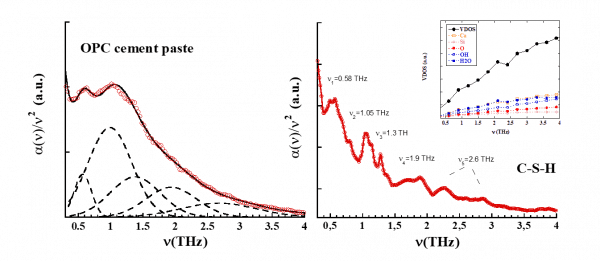The Boson peaks of water govern the THz response of cement-based materials
To find materials with an appropriate response to THz radiation is key for the incoming THz technology revolution. Unfortunately, this region of the electromagnetic spectra remains largely unexplored in most materials. In particular, ubiquitous and cheap materials like cementitious materials deserve due attention.
Cementitious materials contain many structural features that seem to favour the response to the THz radiation. On the one hand, their local structure is glassy and amorphous, something which is known to give rise to an overpopulation of vibrational states at the THz frequencies, the so-called Boson Peaks. On the other hand, they contain plenty of water molecules that strongly interact with light due to their intrinsic electric dipole. Besides, the nanoporous skeleton of cement-based materials provides a rich topology for investigating the intrinsic bosonic states of water, often studied in supercooled or nanoconfined water.
In this work, researchers from the CFM, in collaboration with researchers from the TU Delft (Netherlands), Povazska Cementaren (Slovakia) and Huazhong University of Science and Technology (China), have identified the THz fingerprints of cement-based materials. To this end, THz transmission experiments have been carried out over cement pastes in combination with atomistic simulations. Interestingly both the experiments and simulations have revealed that cementitious materials exhibit three main peaks at frequencies around ~0.6 THz, ~1.05 THz and ~1.35 THz, which are related to the Bosonic states of their water content. Additionally, two extra signals appear at ~1.95 THz and ~2.75 THz, coming from modes of the floppy parts of the dried skeleton.

Figure: (a) Experimental absorbance of the Ordinary Portland Cements (OPC) cement paste, together with the deconvolution of the spectra. (b) Computational prediction of the absorbance of C-S-H gel (the most important ingredient of cementitious materials). In the inset the Vibrational Density of States (VDOS) and their projections are displayed.



